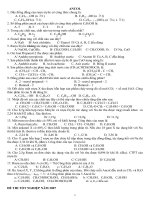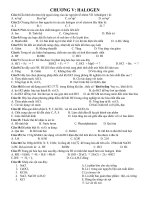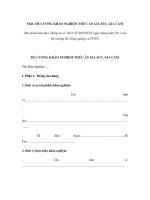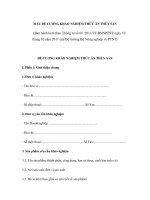Đề cương trắc nghiệm Hành Vi Tổ Chức (Organizational Behavior) CHƯƠNG 4
Bạn đang xem bản rút gọn của tài liệu. Xem và tải ngay bản đầy đủ của tài liệu tại đây (40.44 KB, 13 trang )
Chapter 4: Applied Motivation Practices
4-1. People who believe that money is evil and should be
squandered:
a.
have a strong preference for gainsharing plans
b.
have a strong need for status.
c.
have a strong preference for competency-based
rewards.
d.
tend to define themselves in terms of their wealth.
e.
Have a weak money ethic.
4-2. Which of the following is most likely to be a type of
membership or seniority-based reward?
a.
Employee benefits
b.
Pay increase resulting from a promotion.
c.
Employee share ownership plan
d.
Royalities
e.
Gainsharing
4-3. Which of the following is a competency-based reward?
a.
Gainsharing.
b.
Pay increase resulting from a promotion.
c.
Skill-based pay plan
d.
Merit increase based on performance appraisal results.
e.
Additional week of paid vacation after completing five
years of service with the company.
4-4. Membership-based pay practices:
a.
encourage poor performers to voluntarily leave the
organization.
b.
are difficult to apply in organizational settings
c.
increase the probability that good performers are
lured to other organizations.
d.
directly motivate job performance
e.
do all of the above.
4-5. Job evaluation systems try to maintain:
a.
internal equity.
b.
pay surveys.
c.
competencies.
d.
performance-based rewards.
e.
seniority.
4-6. Which of these rewards is consistent with the emerging
view that people are hired into organizations, not specific jobs?
a.
Seniority-based
b.
Competency-based
c.
Job status-based
d.
Membership-based
e.
Performance-based
4-7. Which of these is not typically an individual performancebased reward?
a.
Royalties
b.
Commissions
c.
Gainsharing
d.
Piece rate
e.
Merit pay
4-8. Which of these is a team reward that motivates team
members to reduce costs and increase labour efficiency in their
work process?
a.
profit-sharing
b.
royalities
c.
ESOP
d.
Share options
e.
gainsharing
4-9. Merit pay increases:
a.
Are becoming less common in organizations.
b.
Are similar to ESOPs
c.
Have replaced job evaluation plans in most
organizations.
d.
Represent the most common form of competency-
based reward.
e.
Are all of the above.
4-10. Scientific management is most closely related to the
process of:
a.
Self-leadership
b.
Job evaluation.
c.
Job specialization.
d.
Constructive thought patterns
e.
Job enrichment
4-11. Skill variety, task identity, and task significance:
a.
Are the main outcomes of job enlargement.
b.
Represent the first three steps in self-leadership.
c.
Mainly affect the experienced meaningfulness of
work.
d.
Are the feelings that people experience when they
have a strong money ethic.
e.
Are the main outcomes of scientific management.
4-12. In job design, autonomy is increased mainly through:
a.
Empowerment.
b.
Job rotation.
c.
Job specialization.
d.
Job feedback.
e.
None of the above has any effect on autonomy.
4-13. Which of the following practices relies on constructive
thought patterns?
a.
scientific management
b.
self-leadership
c.
job rotation
d.
Job status-based rewards
e.
job enrichment
4-14. Mental imagery
a.
Is a core job characteristics that leads to job
specialization.
b.
occurs after self-reinforcement in the self-leadership
model.
c.
involves visualizing successful completion of the
d.
Is the first step in job rotation.
task
e.
Occurs if a person fails to engage in self-talk.
4-15. Research on self-leadership has concluded that:
a.
Employees rarely apply any component of the model.
b.
These practices generally improve self-efficacy and
motivation.
c.
People with a high degree of conscientiousness are
less likely to use self-leadership.
d.
All of the above are true.
e.
Only 'a' and 'b' are true.
TRUE or FALSE
4-1. Employees with a strong money ethic believe that money is
not inherently evil and should be carefully budgeted.
True
False
4-2. The largest portion of most paycheques is based on
membership and seniority.
True
False
4-3. Job evaluation is mainly used to calculate performancebased rewards.
True
False
4-4. Membership-based rewards have been praised for
developing a better-skilled and more flexible workforce.
True
False
4-5. Gainsharing plans create a reasonably strong performanceto-outcome expectancy because much of the cost reduction and
labour efficiency is within the team's control.
True
False
4-6. The trend toward employability means that organizations
today are moving toward offering life-long employment to
employees to ensure their loyalty.
True
False
4-7. Perhaps the most important reason why job specialization
has been more successful than expected is that it incorporates
the motivational potential of jobs.
True
False
4-8. According to the Job Characteristic Model, skill variety,
task identity, and task significance directly contribute to the
feeling of experienced responsibility.
True
False
4-9. Job enlargement combines tasks into one job.
True
False
4-10. One way to enrich jobs is to organize tasks into a natural
grouping, such as completing a whole product.
True
False
4-11. Given its high success rate, job design interventions face
practically no resistance to change.
True
False
4-12. Self-leadership involves finding ways to reduce horizontal
and vertical job specialization.
True
False
4-13. The practice of anticipating and working out solutions to
potential obstacles in our work is called mental imagery.
True
False
4-14. Employees with a high degree of conscientiousness have a
more natural tendency to apply self-leadership strategies
compared to people with lower conscientiousness scores.
True
False









